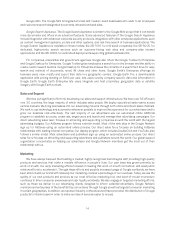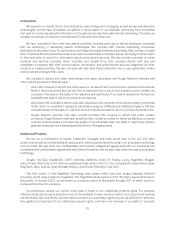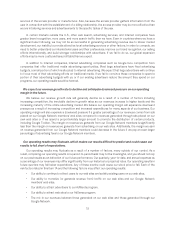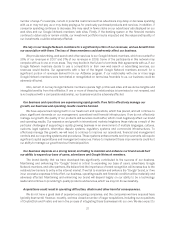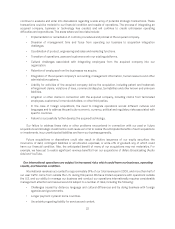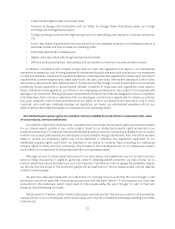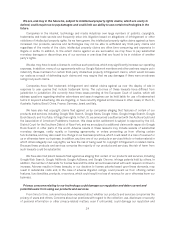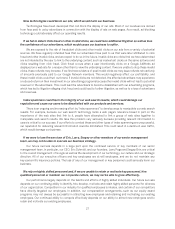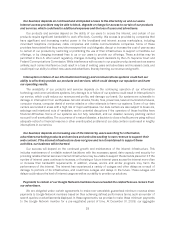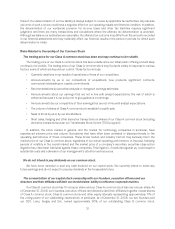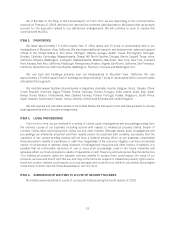Google 2008 Annual Report Download - page 39
Download and view the complete annual report
Please find page 39 of the 2008 Google annual report below. You can navigate through the pages in the report by either clicking on the pages listed below, or by using the keyword search tool below to find specific information within the annual report.• Credit risk and higher levels of payment fraud.
• Currency exchange rate fluctuations and our ability to manage these fluctuations under our foreign
exchange risk management program.
• Foreign exchange controls that might prevent us from repatriating cash earned in countries outside the
U.S.
• Import and export requirements that may prevent us from shipping products or providing services to a
particular market and may increase our operating costs.
• Potentially adverse tax consequences.
• Higher costs associated with doing business internationally.
• Different employee/employer relationships and the existence of workers’ councils and labor unions.
In addition, compliance with complex foreign and U.S. laws and regulations that apply to our international
operations increases our cost of doing business in international jurisdictions and could expose us or our employees
to fines and penalties. These numerous and sometimes conflicting laws and regulations include import and export
requirements, content requirements, trade restrictions, tax laws, sanctions, internal and disclosure control rules,
data privacy requirements, labor relations laws, U.S. laws such as the Foreign Corrupt Practices Act, and local laws
prohibiting corrupt payments to governmental officials. Violations of these laws and regulations could result in
fines, criminal sanctions against us, our officers or our employees, prohibitions on the conduct of our business and
damage to our reputation. Although we have implemented policies and procedures designed to ensure compliance
with these laws, there can be no assurance that our employees, contractors or agents will not violate our policies.
Any such violations could include prohibitions on our ability to offer our products and services to one or more
countries, and could also materially damage our reputation, our brand, our international expansion efforts, our
ability to attract and retain employees, our business and our operating results.
Our intellectual property rights are valuable, and any inability to protect them could reduce the value
of our products, services and brand.
Our patents, trademarks, trade secrets, copyrights and other intellectual property rights are important assets
for us. Various events outside of our control pose a threat to our intellectual property rights as well as to our
products and services. For example, effective intellectual property protection may not be available in every country
in which our products and services are distributed or made available through the internet. Also, the efforts we have
taken to protect our proprietary rights may not be sufficient or effective. Any significant impairment of our
intellectual property rights could harm our business or our ability to compete. Also, protecting our intellectual
property rights is costly and time consuming. Any increase in the unauthorized use of our intellectual property
could make it more expensive to do business and harm our operating results.
Although we seek to obtain patent protection for our innovations, it is possible we may not be able to protect
some of these innovations. In addition, given the costs of obtaining patent protection, we may choose not to
protect certain innovations that later turn out to be important. Furthermore, there is always the possibility, despite
our efforts, that the scope of the protection gained will be insufficient or that an issued patent may be deemed
invalid or unenforceable.
We also face risks associated with our trademarks. For example, there is a risk that the word “Google” could
become so commonly used that it becomes synonymous with the word “search.” If this happens, we could lose
protection for this trademark, which could result in other people using the word “Google” to refer to their own
products, thus diminishing our brand.
We also seek to maintain certain intellectual property as trade secrets. The secrecy could be compromised by
outside parties, or by our employees, which would cause us to lose the competitive advantage resulting from these
trade secrets.
23



